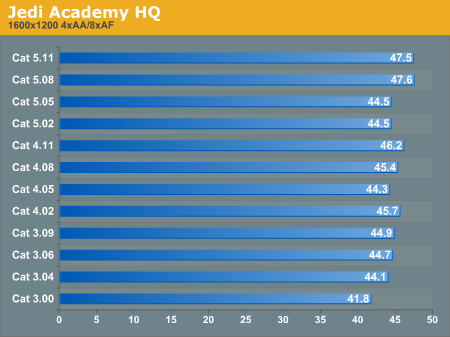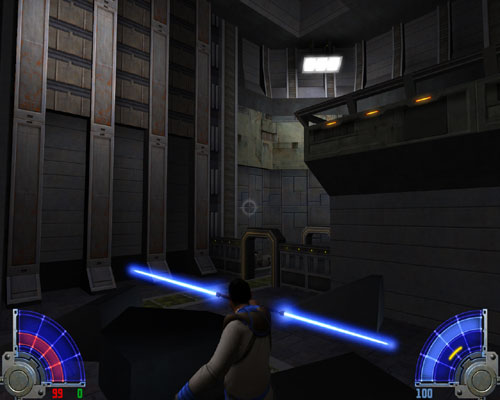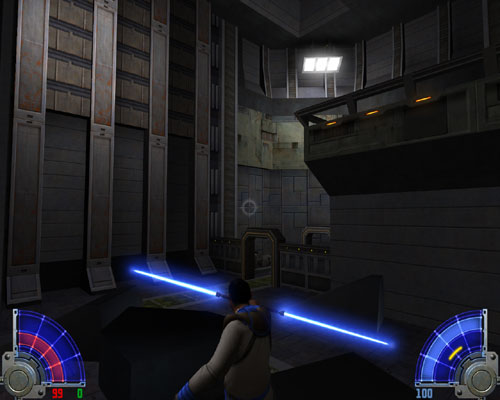Looking Back: ATI's Catalyst Drivers Exposed
by Ryan Smith on December 11, 2005 3:22 PM EST- Posted in
- GPUs
Jedi Knight: Jedi Academy
Released in 2003, Jedi Academy represents the pinnacle of what the Quake3 engine could offer. With massive levels, dynamic glow, and lightsabers abound, it's one of the most punishing Quake3 engine games ever made, and a good representation of the vast number of games made in the early 2000's with this engine. As our only OpenGL title in this roundup, it's also our gauge to see if ATI's OpenGL performance changed at all over the 3-year period That said, even with ATI's traditionally poor OpenGL performance, we still had to increase our testing resolution to 1600x1200 in order to put a sizable dent in to our test setup; otherwise, we would continuously hit the 100fps frame rate cap.
Looking at the screen captures, however, we see a very interesting story that the benchmarks do not show, and it's not all performance related.
Overall, however, Jedi Academy shows that other than early improvements and a bug fix, there was little change in performance in this game with the 9700 Pro.
Released in 2003, Jedi Academy represents the pinnacle of what the Quake3 engine could offer. With massive levels, dynamic glow, and lightsabers abound, it's one of the most punishing Quake3 engine games ever made, and a good representation of the vast number of games made in the early 2000's with this engine. As our only OpenGL title in this roundup, it's also our gauge to see if ATI's OpenGL performance changed at all over the 3-year period That said, even with ATI's traditionally poor OpenGL performance, we still had to increase our testing resolution to 1600x1200 in order to put a sizable dent in to our test setup; otherwise, we would continuously hit the 100fps frame rate cap.


Looking at the screen captures, however, we see a very interesting story that the benchmarks do not show, and it's not all performance related.

Catalyst 3.04 versus 3.00 (mouse over to see 3.00)

Catalyst 3.09 versus 3.06 (mouse over to see 3.06)
Overall, however, Jedi Academy shows that other than early improvements and a bug fix, there was little change in performance in this game with the 9700 Pro.










58 Comments
View All Comments
Ryan Smith - Sunday, December 11, 2005 - link
You should see the cooler attached, it sure sounds like a 757.Anyhow, good catch, thanks.
ss284 - Sunday, December 11, 2005 - link
I think this article might have been a bit more meaningful if some newer generation games were tested, like half life 2 and far cry.ElJefe - Sunday, December 11, 2005 - link
lol yes I thought the same.I was like eh? bf2 and half-life2 and doom3. Or quake 4 maybe. ( even though most gamers are not on that bandwagon yet, bf2 for first person is kinda king still)
Cygni - Tuesday, December 13, 2005 - link
Older drivers are going to have issues with newer games. Thats whats talked about in the article. If you are running Cat 1.0's with FEAR, its going to go ape shit... FEAR wasnt even around when those drivers came out. By using older games, they can limit this factor and make it a pure perforamnce comparison.ksherman - Sunday, December 11, 2005 - link
:(vshah - Sunday, December 11, 2005 - link
Mouseover makes the first image dissapear for me in firefox and ie.Will there be an nvidia version of this?
kerynitian - Monday, December 12, 2005 - link
I would definitely be interested in seeing how nvidida and their driver improvements in the nv40 line related to the marks put up by ati in this article...coldpower27 - Sunday, December 11, 2005 - link
Yes it might be interesting to do one with a 6800 GT/Ultra, to see if there have been improvements of extracting performance out of NV40 technology over the past now 18 months of life.I think we were in the early 61.xx when NV40 came out?
nts - Monday, December 12, 2005 - link
With this article testing on the R300 they would probably test NVIDIA NV30 (FX) cards.coldpower27 - Sunday, December 11, 2005 - link
Actually I beleive that is ~ 20 months instead of 18.